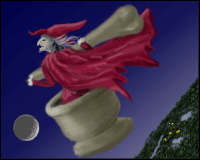16th and 17th Century Folktales
Created | Updated Apr 26, 2006

Once Upon a Time...
Fairy tales. Who can be not familiar with at least one? Cinderella, Puss in Boots? Comforting stories you can safely tuck children up at bedtime with, they are much loved for a while and then eventually outgrown and forgotten about – The End.Nowadays, this is much is true, but the fairy tales of the Disney world of today have travelled a long way from their folk tale roots before a time of celluloid or even books. Over centuries past, these tales have enjoyed such enduring popularity that they have survived down many generations in the oral tradition, kept alive in people’s minds and retold from memory around the fireside by each generation to the next. And with each new telling the tales would undergo a few changes here and there, added according to the imagination and cultural background of the storyteller. These stories had lives of their own and took on the social, political and moral colours of each age and territory they passed through.
Eventually the folk tales were collected together and preserved in print by a handful of pioneering writers. From that time onwards, through successive re-writings, they gradually lost the fluidity of their oral ancestors until they became the standardised versions most of us know today. Nevertheless, in the very early days there were still many different versions of each tale existing side by side with each other. What is more, it would take a rather liberal-minded parent today to consider those early incarnations to be suitable fare for their little ones' bedtime reading. They pulled no punches and rip-roared with bawdiness, dirty dealings, ruthless revenge, innuendo and seriously tough luck.
Three early authors and recorders of folk tales, two Italian and one French, their works spanning the years between 1550 and 1697, have left a legacy of inventive and colourful versions of today’s fairy tales. They are Gianfranco Straparola, who wrote Le Piacevoli Notti (The Pleasurable Nights, first published in Venice in two volumes in 1550 and 1553), Giambattista Basile, who wrote Il Pentamerone in seventeenth century Neapolitan dialect (originally entitled Lo Cunto de li Cunti (The Tale of the Tales) and published posthumously in Naples in two volumes in 1634 and 1636) and Charles Perault, whose Contes de ma Mere l’Oye (Tales of Mother Goose) were first published anonymously in 1697.
English Language Versions of Selected Tales
Straparola's First Tale of the Eleventh Night (Puss in Boots)Basile's Cagliuso (II, 4) (Puss in Boots)
Perault's Le Chat Botte (Puss in Boots)
Straparola's Prencipe di Salerno (I,4)
Basile's La Gatta Cennerentola (I, 6)
Basile's L'Orza (II, 6)
Perault's Cendrillon
Perault's Peau d'Ane
To be continued...

